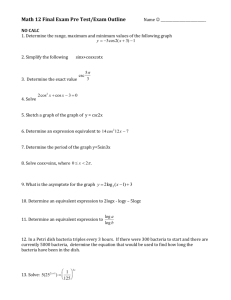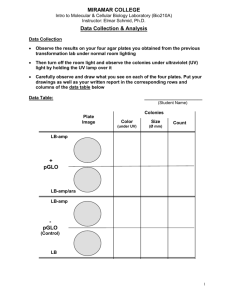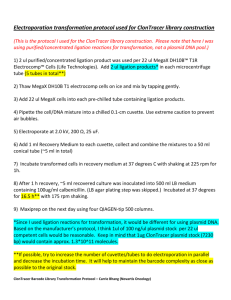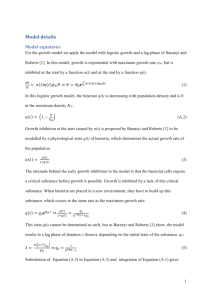Transformation intro
advertisement
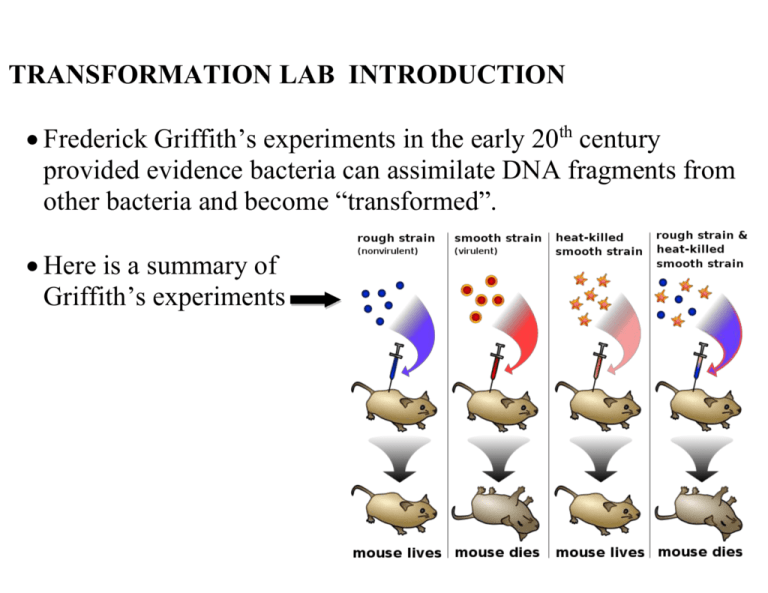
TRANSFORMATION LAB INTRODUCTION Frederick Griffith’s experiments in the early 20th century provided evidence bacteria can assimilate DNA fragments from other bacteria and become “transformed”. Here is a summary of Griffith’s experiments Transformation Experiment Details Only a few species of bacteria are naturally “competent” to take in stray plasmids, so transformation in a natural setting is random and infrequent. Scientists have developed methods to reliably render cells “competent”, including: Chemical environment that includes CaCl2 Alternating cold/heat/cold shock Capturing bacteria in a log phase growth state The problem with transformation procedures: the majority of competent bacteria still do not transform! Thus, you need a way to separate the transformed from non-transformed bacteria. How? Include a gene for antibiotic resistance in the plasmid. Here is how the laboratory transformation process works to produce a bacteria that is “transformed” to be resistant to a certain antibiotic: DETAILS ABOUT OUR TRANSFORMATION PROCEDURE The plasmid: Banana plasmid was created by MIT students in 2006, and they won the IGEM competition for their work. It contains: a replication origin so that it is copied during cell division a gene for ampicillin resistance a yeast gene that encodes for the enzyme ATF-1. ATF-1 converts isoamyl alcohol into isoamyl acetate, an ester that smells like banana. ATF-1 is placed next to a constitutive promoter to allow gene expression Banana plasmid map Making our E. coli “competent”: We are using an E. coli strain YYC912 that is relatively odorless so that the banana aroma can be detected. Here are the steps we take to render it competent: Grow the bacteria in broth Stop its growth while it is in log phase Place the bacteria in cold CaCl2 solution Keep it cold on ice Shock the bacteria for 50 seconds at 42 oC Ice-shock the bacteria again These steps disrupt the bacterial cell membrane to allow plasmid uptake. Without them, transformation would not readily occur. Selecting transformed bacteria: Most of the bacteria will not take in the plasmid. We separate the cooperative “transformed” bacteria from the non-transformed by putting ampicillin in the broth medium. Transformed bacteria will survive ampicillin, but the nontransformed bacteria will not. Efficiency: You will calculate a “transformation efficiency” to measure success. Efficiency is defined as: #colonies/μg plasmid. Expressing the banana gene: The ATF-1 gene in the banana plasmid is placed near a constitutive promoter it will be continually transcribed. The precursor isoamyl alcohol is converted by ATF-1 into an ester that smells like banana. Lab tasks are performed over three class sessions: Day 1 Transformation procedure Plate bacteria for efficiency counts Culture bacteria in ampicillin broth Broth also contains precursor Day 2 Perform colony counts Calculate transformation efficiency Conduct smell tests Report data Day 3 Debrief lab Day 1 Procedure – Standard Protocol Obtain two tubes of competent cells Spin at 11K rpm for 2 minutes Pour off and then pipette out broth Add 250 µL CaCl2 Mix well by pipetting up and down slowly. KEEP ON ICE! Add plasmid to transform tube, ice for 10 minutes. Heat shock at 42 oC for 50 seconds. Immediately place back on ice for 2-5 minutes. 42 oC for 50 seconds Add 250 uL LB broth to each tube Rest at room temperature for 2-5 minutes Add 100 µL of tube contents to appropriate plates. Spread cells onto plate with a sterile disposable loop. Incubate at 37 oC overnight. +plasmid +plasmid 100 µL 100 µL LB/amp/isoamyl LB/amp -plasmid 100 µL LB/amp -plasmid 100 µL LB Day 2: Colony counts and transformation efficiency Count the number of colonies on each plate. Efficiency is calculated as: # colonies/µg of plasmid. We began with plasmid concentration of 10 µg/milliliter and used 10 µL. This corresponds to 0.1 µg (100 nanograms) of DNA in each transformation tube. Plasmid DNA was suspended in 500 µL volume (250 µL CaCl2 + 250 µL broth). We placed only 100 µL of the 500 µL onto each plate. As a result, the equivalent of 0.02 µg or 20 nanograms of plasmid DNA was represented on the plate. Efficiency is: #colonies/.02 µg.





